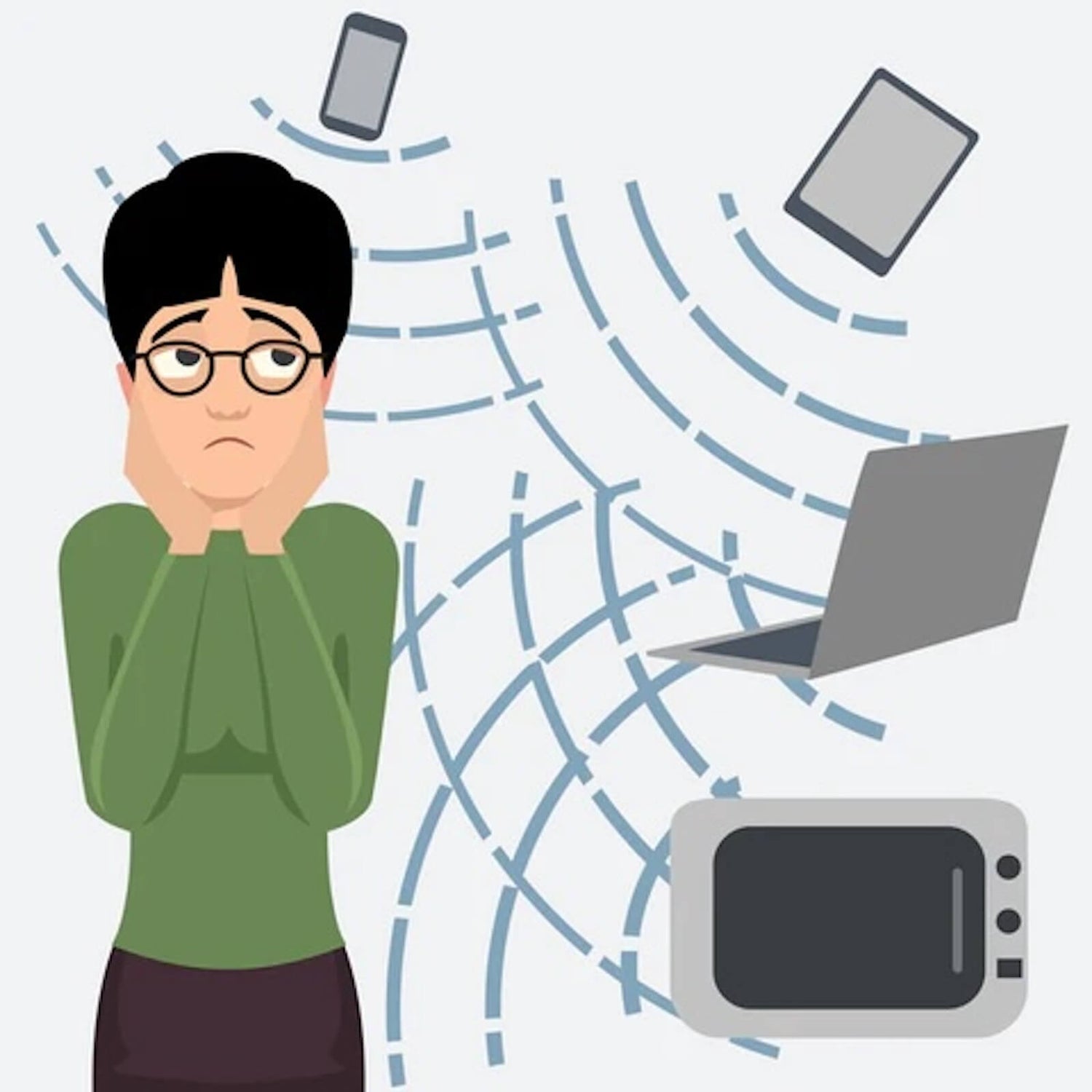EMF & ELF Health Risks: Get The Facts

Do Low Levels of EMF/ ELF Present a Health Hazard to Humans?
-
-
Numerous videos and articles on the Internet and Facebook have proclaimed the possible dangers of low-level electromagnetic fields (EMF) and extremely low frequencies (ELF) emitted by common household electrical products.
To help bring some clarity to this topic, empirical evidence from two credible and impartial reference sources, The Food and Drug Administration and The World Health Organization, are herein provided.
According to the World Health Organization, low levels of ELF and EMF have not been proven to be harmful to human health.
One of the main scare tactics that seem to be prevalent on the internet these days is that low-intensity levels of EMF, with a milliGauss reading of 100 milliGauss or less, are dangerous to human health. But what does that mean?

Here are a few facts to help put in perspective Gauss meter readings of EMF:
Every day, every human on the planet Earth is exposed to the magnetic field emitted by Earth’s interior. This magnetic field is very similar to the forces of EMF found in common electrical appliances but significantly more powerful.
Earth's magnetic field, also known as the geomagnetic field, is the magnetic field that extends from the Earth's interior out into space, where it meets the solar wind, a stream of charged particles emanating from the Sun.

EMF Debunked: Earth's magnetic field
The magnitude of this magnetic field at the Earth's surface measures from 25 to 65 microteslas (0.25 to 0.65 gauss). Therefore, the Earth’s entire surface measures from 250 to 650 milliGauss! By simply being alive, you are automatically exposed to at least that amount every moment of every day, just like every human on Earth who has ever lived! Thus, EMF exposure danger is actually very low as we are all subjected to low levels of EMF daily.
If a magnetic field of this intensity were to be truly harmful to the human body, then everyone on the planet would already be experiencing health problems due to the Earth’s magnetic field.
Typical Exposure Levels at Home and in the Environment
Electromagnetic fields at home
Background electromagnetic field levels from electricity transmission and distribution facilities
Electricity is transmitted over long distances via high-voltage power lines. Transformers reduce these high voltages for local distribution to homes and businesses. Electricity transmission and distribution facilities and residential wiring and appliances account for the home's background level of power frequency electric and magnetic fields. This background field may be up to about 0.2 µT in homes not located near power lines.
Directly beneath power lines, the fields are much stronger. Magnetic flux densities at ground level can range up to several µT. Electric field levels underneath power lines can be as high as 10 kV/m. However, the fields (both electric and magnetic) drop off with distance from the lines. At a 50 m to 100 m distance, the fields normally reach levels in areas away from high-voltage power lines. In addition, house walls substantially reduce the electric field levels from those found at similar locations outside the house.
Electric appliances in the household
The strongest power frequency electric fields ordinarily encountered in the environment exist beneath high-voltage transmission lines. In contrast, the strongest magnetic fields at power frequency are normally found very close to motors and other electrical appliances, as well as in specialized equipment such as magnetic resonance scanners used for medical imaging.
Typical electric field strengths measured near household appliances
(at a distance of 30 cm)
(From: Federal Office for Radiation Safety, Germany 1999)
Many people are surprised when they become aware of various magnetic field levels near various ELF household appliances. The field strength does not depend on how large, complex, powerful, or noisy the device is. Furthermore, even between similar devices, the strength of the magnetic field may vary.
Typical magnetic field strength of household appliances at various distances
| Electric appliance |
3 cm distance (µT) |
30 cm distance (µT) |
1 m distance (µT) |
|---|---|---|---|
| Hair dryer |
6 – 2000 |
0.01 – 7 |
0.01 – 0.03 |
| Electric shaver |
15 – 1500 |
0.08 – 9 |
0.01 – 0.03 |
| Vacuum cleaner |
200 – 800 |
2-20 |
0.13 – 2 |
| Fluorescent light |
40 – 400 |
0.5 – 2 |
0.02 – 0.25 |
| Microwave oven |
73 – 200 |
4 – 8 |
0.25 – 0.6 |
| Portable radio |
16 – 56 |
1 |
< 0.01 |
| Electric oven |
1 – 50 |
0.15 – 0.5 |
0.01 – 0.04 |
| Washing machine |
0.8 – 50 |
0.15 – 3 |
0.01 – 0.15 |
| Iron |
8 – 30 |
0.12 – 0.3 |
0.01 – 0.03 |
| Dishwasher |
3.5 – 20 |
0.6 – 3 |
0.07 – 0.3 |
| Computer |
0.5 – 30 |
< 0.01 |
|
| Refrigerator |
0.5 – 1.7 |
0.01 – 0.25 |
<0.01 |
| Colour TV |
2.5 - 50 |
0.04 – 2 |
0.01 – 0.15 |
|
With most household appliances, the magnetic field strength at a distance of 30 cm is well below the guideline limit for the general public of 100 µT. |
|||
(Source: Federal Office for Radiation Safety, Germany 1999) Normal operating distance is given in bold
The table illustrates two main points: First, the magnetic field strength around all appliances rapidly decreases the further you get away from them. Secondly, most household appliances are not operated very close to the body. At a distance of 30 cm, the magnetic fields surrounding most household appliances are more than 100 times lower than the given guideline limit of 100 µT at 50 Hz (83 µT at 60 Hz) for the general public.
Electromagnetic Fields in the Environment
-
Radar
Radars are used for navigation, weather forecasting, and military applications, as well as a variety of other functions. They emit pulsed microwave signals. The peak power in the pulse can be high even though the average power may be low. Many radars rotate or move up and down; this reduces the mean power density to which the public is exposed in the vicinity of radars.Even high-power, non-rotating military radars limit exposures to below-guideline levels at locations of public access.
-
Security systems
Anti-theft systems in shops use tags detected by electrical coils at the exits. When a purchase is made, the tags are removed or permanently deactivated. The electromagnetic fields from the coils do not generally exceed exposure guideline levels. Access control systems work the same way with the tag incorporated into a key ring or identity card. Library security systems use tags that can be deactivated when a book is borrowed and reactivated when it is returned. Metal detectors and airport security systems set up a strong magnetic field of up to 100 µT that is disturbed by the presence of a metal object. Magnetic field strengths may approach and occasionally exceed guideline levels close to the detector's frame. However, this does not constitute a health hazard, as will be discussed in the section on guidelines.
-
Electric trains and trams
Long-distance trains have one or more engine cars separate from the passenger cars. Thus, passenger exposure comes mainly from the electricity supply to the train. Magnetic fields in the passenger cars of long-distance trains can be several hundred µT near the floor, with lower values (tens of µT) elsewhere in the compartment. Electric field strengths may reach 300 V/m. People living near railway lines may encounter magnetic fields from the overhead supply, which, depending on the country, may be comparable to the fields produced by high-voltage power lines.
Motors and traction equipment of trains and trams are normally located underneath the floors of passenger cars. At floor level, magnetic field intensities may amount to tens of µT in regions of the floor just above the motor. The fields fall off quickly with distance from the floor, and exposure of the upper bodies of passengers is much lower. -
Mobile phones and their base stations
Mobile phones allow people to be within reach at all times. These low-power radiowave devices transmit and receive signals from a network of fixed low power base stations. Each base station provides coverage to a given area. Depending on the number of calls being handled, base stations may be from only a few hundred metres apart in major cities to several kilometres apart in rural areas.
Concerns about other non-thermal effects from exposure to mobile phone frequencies have also been raised. These include suggestions of subtle effects on cells that could affect cancer development.Effects on electrically excitable tissues that may influence the function of the brain and nervous tissue have also been hypothesized. However, the overall evidence available to date does not suggest that the use of mobile phones has any detrimental effect on human health.
-
TV and radio
When choosing a radio station on your stereo at home, have you ever wondered what the familiar abbreviations AM and FM stand for? Radio signals are described as amplitude-modulated (AM) or frequency-modulated (FM), depending on the way in which they carry information. AM radio signals can be used for broadcasting over very long distances, whereas FM waves cover more localized areas and can produce better sound quality.
AM radio signals are transmitted via large arrays of antennas, which can be tens of meters high, on sites that are off-limits to the public. Exposures very close to antennas and feed cables can be high, but these would affect maintenance workers rather than the general public.
TV and FM radio antennas are much smaller than AM radio antennas and are mounted in arrays at the top of high towers. The towers themselves serve only as supporting structures. As exposures near the foot of these towers are below guideline limits, public access to these areas may be possible. Small local TV and radio antennas are sometimes mounted on the top of buildings; if this is the case,it may be necessary to control access to the roof.

Magnetic fields in everyday life: are they really that high?
In recent years, national authorities in different countries have conducted many measurements to investigate electromagnetic field levels in the living environment. None of these surveys has concluded that field levels could bring about adverse health effects.

Key points of these surveys:
- Background electromagnetic field levels in the home are mainly caused by the transmission and distribution facilities for electricity or by electrical appliances.
- Electrical appliances differ greatly in the strength of fields they generate. Both electric and magnetic field levels decrease rapidly with distance from the appliances. In any event, fields surrounding household appliances usually are far below guideline limits.
- At operator positions, the electric and magnetic fields of television sets and computer screens are hundreds of thousands of times below guideline levels.
- Microwave ovens meeting the standards are not hazardous to health.
- As long as close public access to radar facilities, broadcasting antennas and mobile phone base stations is restricted, exposure guideline limits for radiofrequency fields will not be exceeded.
- The user of a mobile phone encounters field levels that are much higher than any levels in the normal living environment. However, even these increased levels do not appear to generate harmful effects.
- Many surveys have demonstrated that exposure to electromagnetic field levels in the living environment is extremely low.

Article on ELF (Extremely Low Frequency) Electrical Field Emissions by Cancer.Org
This article essentially states that ELF from the electrical wiring in common household electrical appliances has NOT been shown to cause cancer and that there is little to no reason for any health concern regarding ELF radiation cancer risk.
Primary causes for possible ELF health concerns emanate from large power and electrical relay stations, not common household appliances nor Far Infrared Sauna heater panels or sauna wiring.
Power Lines, Electrical Devices, and Extremely Low-Frequency Radiation
What is extremely low frequency (ELF) radiation?
Radiation is the emission or sending out of energy from any source. X-rays are an example of radiation, but so is the light from the sun and the heat that constantly comes off our bodies.
When talking about radiation and cancer, many people think of specific kinds of radiation, such as X-rays or the radiation in nuclear reactors. However, these are not the only types of radiation that concern us when we think about radiation risks to human health.
Radiation exists across a spectrum from very high-energy (also referred to as high-frequency) radiation to very low-energy (or low-frequency) radiation. This is sometimes referred to as the electromagnetic spectrum.
Examples of high-energy radiation include X-rays and gamma rays. They, as well as some higher-energy ultraviolet (UV) rays, are classified as ionizing radiation, which means that they have enough energy to remove an electron from (ionize) an atom. Ionizing radiation can damage the DNA inside cells, which can lead to mutations and the uncontrolled cell growth we know as cancer.
Extremely low frequency (ELF) radiation is at the low-energy end of the electromagnetic spectrum and is a type of non-ionizing radiation. Non-ionizing radiation has enough energy to move atoms around or make them vibrate, but not enough to directly damage DNA. ELF radiation has even lower energy than other types of non-ionizing radiation like radiofrequency radiation, visible light, and infrared.
With most types of radiation, the electric and magnetic fields are coupled. Because they act as one, they are considered together as an electromagnetic field (EMF). However, with ELF radiation, the magnetic field and the electrical field can exist and act independently, so they are often studied separately. Typically, we use the term “magnetic field” to indicate ELF radiation from a magnetic field, while we use “electric field” to mean ELF radiation from an electric field.
The possible link between electromagnetic fields and cancer has been a subject of controversy for several decades. It's not clear exactly how electromagnetic fields, a form of low-energy, non-ionizing radiation, can increase cancer risk. Plus, because we are all exposed to different amounts of these fields at different times, the issue has been hard to study.

Electric and magnetic fields
All radiation on the electromagnetic spectrum is produced by the interactions of 2 forces, referred to as fields. Radiation has both an electric field and a magnetic field.
Electric fields are the forces acting on charged particles (parts of atoms), like electrons or protons, which cause them to move. Electric current is simply the flow of electrons produced by an electric field. The strength of an electric field is often expressed as volts per meter (V/m) or, for stronger fields, as kilovolts per meter (kV/m), where a kilovolt is 1000 volts.
A magnetic field is created when charged particles are in motion. The strength of a magnetic field can be expressed in many different units, including Tesla (T), microtesla (µT or one-millionth of a Tesla), and Gauss (G), where one G equals 100 µT.

How are people exposed to ELF radiation?
Generating, transmitting, distributing, and using electricity all expose people to ELF radiation. Power lines, household wiring, and any device that uses electricity can generate ELF radiation. Thus any electric device, from refrigerators and vacuum cleaners to televisions and computer monitors (when they are on) are sources of ELF radiation. Even electric blankets expose people to ELF radiation.
How much electromagnetic radiation you are exposed to depends on the strength of the electromagnetic field, your distance from the source of the field, and the length of time you are exposed. The highest exposure occurs when the person is very close to a source, putting out a strong field, and stays there for a long period.
Any Questions
Does ELF Radiation Cause Cancer?
Studies in the lab
Several large studies have examined the possible effects of ELF magnetic fields on cancer in rats and mice. These studies exposed the animals to magnetic fields much stronger than what people are normally exposed to at home, with fields ranging from 2 to 5000 microtesla (µT).
Most of these studies have found no increase in cancer risk. The risk of some types of cancer was lower in the animals exposed to the ELF radiation. One study did show an increased risk of tumors that start in thyroid cells, called C-cells, in male rats at some exposures. This increased risk was not seen in female rats or in mice and was not seen at the highest field strength.
These inconsistencies, and the fact that these findings were not consistently seen in the other studies, make it hard for scientists to conclude that the observed increased risk of tumors is from the ELF radiation.
Other studies in mice and rats have looked specifically for increases in leukemia and lymphoma as a result of exposure to ELF radiation, but these studies have also not found a link.
Studies in people
Studying the effects of ELF radiation on people can be hard for many reasons:
Exposure to ELF radiation is very common, so it’s impossible to compare people who are exposed to ELF radiation with those who aren’t. Instead, studies try to compare people exposed at higher levels with people exposed at lower levels.
It is very hard to determine how much ELF radiation a person has been exposed to, especially over a long period. As far as we know, the effects of ELF radiation do not add up over time, and there is no test that can measure how much exposure a person has had.
Researchers can get a snapshot of ELF exposures by having a person wear a device that records their exposure levels over hours or days. Or, researchers can measure the magnetic or electrical field strength in a person’s home or workplace settings.
Other options include estimating exposure based on the wiring configuration of someone’s workplace/home or on its distance from power lines. However, these methods result in exposure estimates that have a lot of uncertainty and that can produce biased estimates of total exposure. They typically do not account for a person’s ELF exposures while in other places, they don’t measure ELF exposures in every location that person has ever lived or worked over their lifetime.
As a result, there are no good ways to accurately estimate someone’s long-term exposure, which is what matters most when looking for possible effects on cancer risk.
What expert agencies say
Several national and international agencies study different exposures in the environment to determine if they can cause cancer (something that causes cancer or helps cancer grow is called a carcinogen). The American Cancer Society looks to these organizations to evaluate the risks based on evidence from laboratory, animal, and human research studies.
Based on animal and human evidence like the examples above, some expert agencies have evaluated the cancer-causing nature of ELF radiation.
The International Agency for Research on Cancer (IARC) is part of the World Health Organization (WHO). One of its major goals is to identify the causes of cancer. In 2002, IARC considered the evidence for ELF magnetic and electric fields separately:
- It found “limited evidence” in humans for the carcinogenicity of ELF magnetic fields in relation to childhood leukemia, with “inadequate evidence” in relation to all other cancers. It found “inadequate evidence” for the carcinogenicity of ELF magnetic fields based on studies in lab animals.
- It found “inadequate evidence” for the carcinogenicity of ELF electric fields in humans.
Based on this assessment, IARC has classified ELF magnetic fields as “possibly carcinogenic to humans.” It has classified ELF electric fields as “not classifiable as to their carcinogenicity to humans.”
In 1999, the US National Institute of Environmental Health Sciences (NIEHS) described the scientific evidence suggesting that ELF exposure poses a health risk as “weak,” but noted that it cannot be recognized as entirely safe, and considered it to be a “possible” human carcinogen.

How Can I Avoid Exposure to ELF Radiation?
It’s not clear that exposure to ELF radiation is harmful, but there are things you can do to lower your exposure if you are concerned. Your exposure is based on the strength of the ELF radiation coming from each source, how close you are to each, and how long you spend in the field.
The NIEHS recommends that people concerned about their exposure to EMF (and ELF radiation) find out where their major EMF sources are and move away from them or limit the time spent near them. For example, moving even an arm’s length away from a source can dramatically lower exposure to its field.
Experience the Difference Today
Discover the craftsmanship, quality, and care that goes into every Rocky Mountain Sauna. Shop Our Saunas Now and bring the ultimate in relaxation and wellness to your home.

